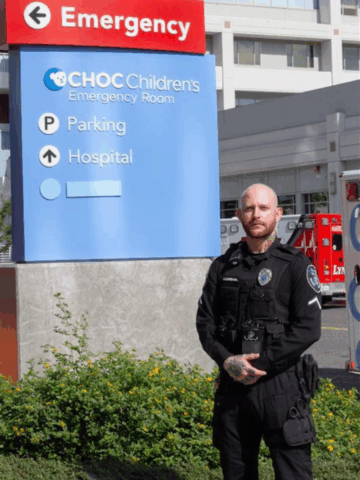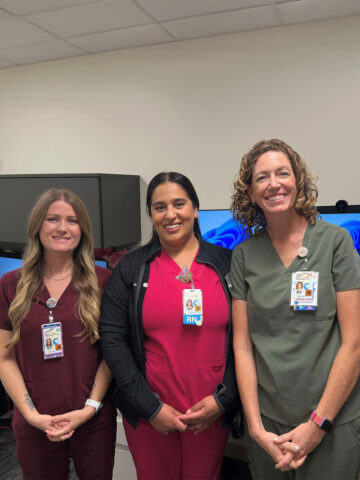More than 30 years ago, South Orange County was a different place.
Most of its cities were unincorporated or newly incorporated, Mission Viejo’s population stood at just about 70,000 people (it’s now about 94,000), and if a family had a child seeking specialized medical care, they would need to drive about 20 miles north to CHOC in Orange.
Healthcare leaders, however, saw the region’s burgeoning growth and the needs it would generate.
“CHOC’s vision has always been to serve all the children in Orange County, and that was hard for us to do in Orange alone in a county this spread out,” says CHOC Dr. Gary Goodman.
The answer? South Orange County’s very own pediatric hospital.
Everyone’s brighter here. You can let your inner-kid come out. I always joke that I go to work to play with kids and be a kid.”
-Kaylee Link, RN, pediatrics, on what makes CHOC Mission so special
Born from CHOC’s vision to care for every child in Orange County, CHOC at Mission Hospital opened 30 years ago this year, marking three decades of innovation, advancement and care for its community.
“For those of us who live in South County and work here, we’re constantly taking care of families from the cities where we live,” says Dr. Goodman, who serves as medical director of CHOC Mission’s pediatric intensive care unit (PICU) . His tenure with CHOC began almost a decade before CHOC Mission had even been conceived.
“It’s special because it’s personal,” Dr. Goodman adds.
Walking through CHOC Mission, patients and families feel that personal touch, employees say. They see it in the hospitality of the care teams looking after them, the close-knit friendships among staff, many of whom say they’ve cared for families they know from church, school or kids sports leagues.
“These are literally our kids,” says Bronwyn Stackleather, CHOC Mission’s director of patient care services.

Humble beginnings
The hospital’s beginnings were humble.
“During that time, Mission Hospital had proposed building a five-story tower and there was some confluence of ideas: We have pediatrics. We have a PICU and a neonatal unit. They’re opening a tower. There’s an empty fifth floor – a light bulb came on,” Dr. Goodman says. “Let’s build a children’s hospital at Mission Hospital!”
On the day patients were wheeled across the property into the new tower in 1993, Dr. Goodman — who had been a CHOC doctor since 1984 — said it “felt like home.”
Our leaders have this remarkable ability to get everyone around them engaged and you feel yourself lighting up talking about it. Healthcare is so rapid and the science of medicine changes so fast, to stand still means you’re going backwards, so we’re constantly on a journey of change. Our kids deserve this; our staff deserve this; our families deserve this.”
–Bronwyn Stackleather, RN, director of patient care services, on what makes CHOC Mission so special
Karen Mish, CHOC Mission’s pediatrics unit manager, described it as one of the most gratifying moments of her career.
“That was a big deal,” she says.
In the three decades since that day, they’ve continued to innovate, opening a sleep center; launching an internationally renowned eating disorder program; earning a pediatric trauma designation; and gaining California Children’s Services (CCS) designation to care for Orange County’s most vulnerable children, among dozens of other notable milestones.
Culture is key
But what makes CHOC Mission special are its people and the inclusive, tight-knit culture they’ve created.
They organize game nights and social outings; lean upon one another for support; babysit one another’s children; raise their kids in the same towns and have become a family.
“When I talk to parents, I always say, ‘It’s our family taking care of your family,’” says Liz Drake, a clinical nurse specialist in the neonatal intensive care unit (NICU), who has worked at CHOC for more than 40 years.
At CHOC Mission, it’s common to see doctors, nurses and clinical associates shoulder-to-shoulder in the same station as they chart. Everyone’s on a first-name basis.
“When you work closely with a small group of people, you get to know them clinically and personally,” said Dr. Jennifer Ho, a hospitalist at CHOC Mission.
“Some travelers come down here and they’re always shocked that we’re all friends on the outside,” says Kimberly Stetter, a nurse.
Dr. Goodman attributes much of the hospital’s success to that culture, a lack of hierarchy and the concept that anybody can learn from someone else – no matter their title or experience level.
“It’s like a family environment here and you have people looking out for each other, and we all hold ourselves to very high standards in providing excellent care.”
-Dr. Jennifer Ho, hospitalist and chief of staff, on what makes CHOC Mission so special
When families visit the PICU, where the most serious traumas and conditions are treated, the environment isn’t what they might expect, Dr. Goodman says. “It’s not all doom and gloom.”
“I’m a happy person, and I love life,” Dr. Goodman said. “I’m the captain of the ship in charge of the unit, and when I come into work every day happy and excited about what I’m doing and joyful to help kids get better, the whole staff picks that up and they embrace it, and we have a happy unit.”

At the same time, the team has cultivated a culture of psychological safety that allows employees to feel comfortable being vulnerable, asking questions and learning from mistakes.
Kaylee Link, an early-career nurse, began her healthcare career at CHOC Mission as a clinical associate. After she got her RN license, she chose to remain at CHOC because of that sense of psychological safety, she said.
“When you start out as a nurse, it’s super scary. You don’t want to do anything wrong, and you need a good support system,” Kaylee says. “I didn’t want to leave that here. I knew I would get good experience and fall back on people who love me and I can be comfortable with.”
That safe, close-knit culture at CHOC Mission has been engrained because people have lived it, says Liz, the NICU clinical nurse educator.
“You have to live the culture you want. You can’t say it and not do it,” Liz says. “Culture are the conditions you live in, and I want to be part of conditions where people can feel safe, say anything and not feel judged, where people can make mistakes, where even when there’s generational differences we can laugh together, have fun together, help a baby survive and help a family thrive.”
A commitment to excellence, innovation
Their commitment to innovation and continuous improvement is palpable. Walk down the hallways and you’ll find posters and presentations marking progress on various initiatives undertaken by employees, all in the effort of delivering even higher-quality care for kids.
Just last year, the hospital sent nine employees from across different departments to CHOC’s performance excellence program that teaches students comprehensive improvement science approaches to improving processes.
“It stems from the dedication to our patients,” says Karen, the pediatrics manager. “We want the best for them.”
Much of CHOC Mission’s culture has been marked by a steady drumbeat of improvement. If anything doesn’t meet their standards — from asthma education to lactation services — they address it, Karen says.
“We’re small and we can make changes rapidly,” she says.
And because of CHOC Mission’s size, willingness to try new things and dedication to continuous improvement, it’s been the site of many trials, says Eva Esmaeli, NICU nurse manager.
“One of the best things about it that I love here is the teamwork. If I need help, somebody’s going to be here to throw me a lifeline and save me.”
-Danielle Hillburn, RN, pediatrics, on what makes CHOC Mission so special
It was one of the first 150 hospitals in the nation to introduce RQI for continuing resuscitation education and testing for clinical associates and was the trial site for a new pulse oximeter probe from medical device company Masimo.
“This is what CHOC Mission does,” Eva says. “It’s our expectation, dedication and commitment to always improving.”
And after 30 years, they’re still innovating and breaking barriers.
Just this year, CHOC Mission’s NICU performed its first skin-to-skin hold on a high-frequency ventilator. Unlike a traditional ventilator, a high-frequency ventilator has a shorter, more rigid circuit connecting the baby to the machine.
Returning visitors
For Karen, some of the most gratifying moments are when patients had such extraordinary experiences that they were inspired to pursue a career in healthcare.
She can count at least three people in the last decade who have passed through CHOC Mission’s doors twice – the first time as patients, and the second as CHOC employees working on the same unit where they received care as kids.
“When that happens, you feel like you’ve done your job. If you were able to care for that person so much that they wanted to achieve that and give it back to someone else, you really made a difference,” Karen says.
That was the case for Jillian Lee, a clinical nurse specialist in the PICU and pediatrics unit,. Her experience as a meningitis patient at CHOC’s Orange campus at age 4 was her first exposure to healthcare.

In her office hangs a shadow box displaying a well-worn pillow in the image of Choco Bear, CHOC’s beloved mascot, that all pediatrics patients once received and a photo of her in the hospital.
She remembers the day the photo was taken, the nurses who streamed in and out of her room, and curiously wondering what they were doing. It sparked her imagination and for the first time, she remembers wanting to pursue a career in healthcare.
“It’s the people here. It’s a little slice of heaven.”
– Adelina Hinojosa, senior staffing coordinator, on what makes CHOC Mission so special
That 4-year-old version of herself couldn’t have imagined where she is now, using evidence-based practices to help nurses continually innovate, improve and advance care at the health system where she was a patient so many years ago.
“I love that you get a small team here that takes excellence so seriously because this is our community we’re caring for,” Jillian says.
“We have this beautiful thing where we are small, but we’re connected to big programs,” Jillian says.
In the 30 years since opening its doors, a lot has changed. Patient care has evolved; technologies have advanced; new specialties have emerged and the model for care has matured.
“What hasn’t changed is the feeling when you come here,” Dr. Goodman says. “The heart of the hospital is the same.”




